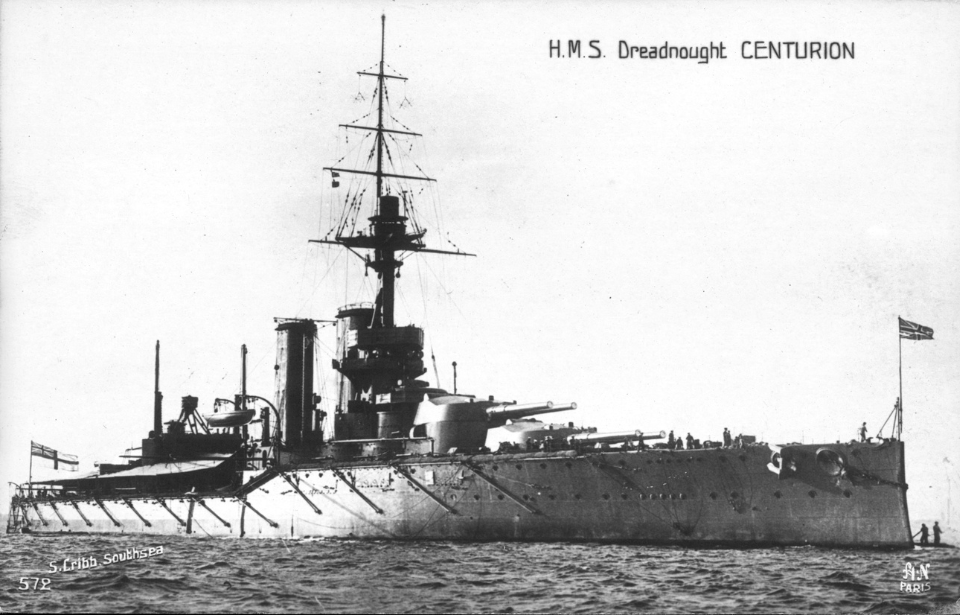The HMS Centurion (1911) was the second of four King George V-class dreadnought battleships. She served with the Royal Navy between 1913-44, seeing action throughout the First World War, including the Battle of Jutland. During World War II, the vessel was purposefully sunk on June 9, 1944, acting as a blockship in support of the invasion of Normandy.
Design and construction of the HMS Centurion (1911)
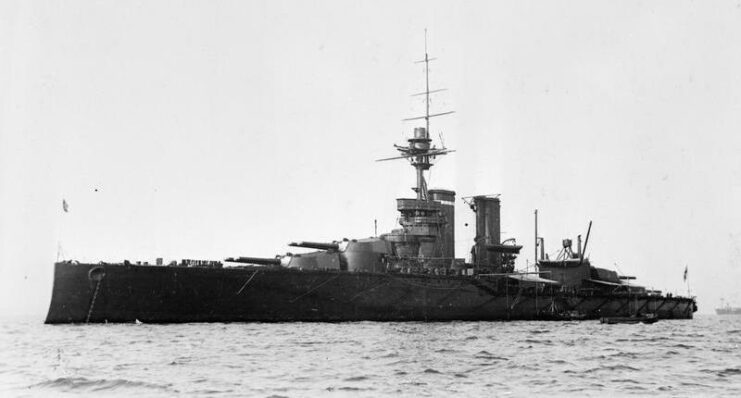
The HMS Centurion was laid down on January 16, 1911 and commissioned into the Royal Navy on May 22, 1913. Similar to the other dreadnoughts that made up the King George V-class, she had a displacement of 25,420 long tons, a length of over 597 feet, a beam of 89 feet and a draught of nearly 29 feet.
Two sets of Parsons direct-drive steam turbines, each driving two shafts, powered Centurion. These allowed the dreadnought to hit speeds of up to 21 knots, with a range of 6,310 nautical miles at 10 knots.
Centurion was armed with 10 breech-loading (BL) 13.5-inch Mark V guns in five twin-gun turrets. She also had 16 BL four-inch Mark VII guns as her secondary armament, as well as three 21-inch torpedo tubes, one on either side of the bow and one at the stern.
Service during World War I
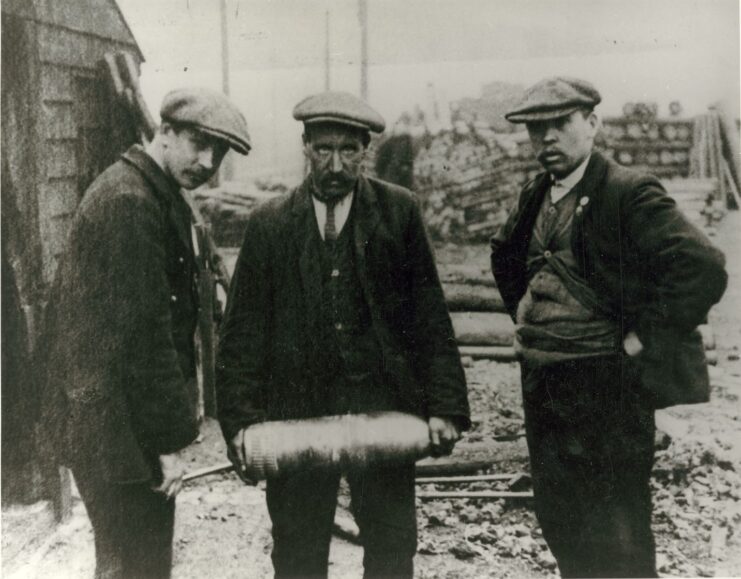
Between July 17-20, 1914, the HMS Centurion took part in test a mobilization and was ordered to Scapa Flow with the Home Fleet, in preparation for a possible attack by the Imperial German Navy. With the outbreak of the First World War that summer, the fleet transitioned into the Grand Fleet, and Centurion joined the Second Battle Squadron.
The dreadnought spent most of the conflict in and around British waters. During the German raid on Scarborough, Hartlepool and Whitby, Centurion was present in the British defenses, alongside her sister ships, the HMS King George V (1911) and Ajax (1912). None of them engaged the enemy.
Centurion missed out on the Battle of Dogger Bank in 1915, but got a piece of the action at the Battle of Jutland the following year.
Battle of Jutland
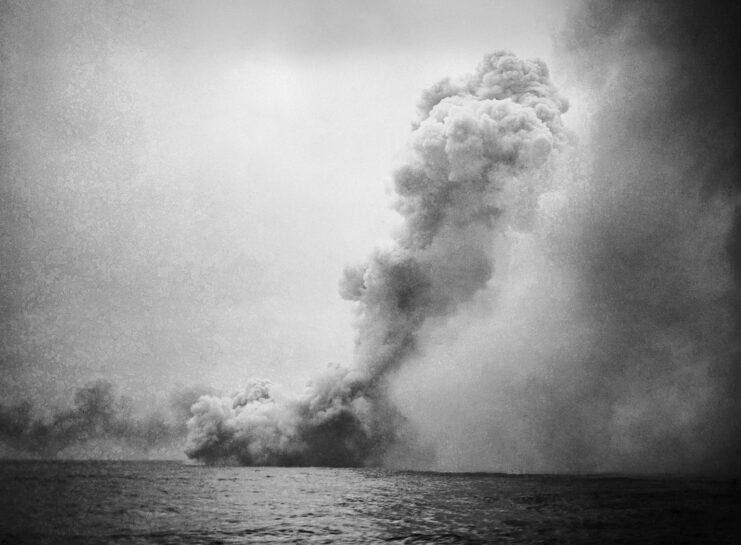
The Battle of Jutland, also known as the Battle of Skagerrak, was a significant naval engagement fought between May 31-June 1, 1916, near the coast of Denmark’s Jutland Peninsula. It involved the Royal Navy’s Grand Fleet, commanded by Adm. Sir John Jellicoe, and the Imperial German Navy’s High Seas Fleet, under the leadership of Vice Adm. Reinhard Scheer.
The clash between the two was a pivotal moment in the war, as it represented an attempt by the German Navy to break the British naval blockade and gain control of the North Sea. The objective was to lure and engage portions of the Grand Fleet, in the hope of inflicting damage and gaining a strategic advantage. The British, having intercepted German radio communications, were aware of the plans and set out to intercept the High Seas Fleet.
On the afternoon of May 31, the two naval forces made contact near the coast of Denmark. The battle commenced with long-range gun exchanges between the capital ships of both fleets, with the engagement overall being characterized by its massive scale and complexity. It involved 250 ships, and both sides suffered heavy losses, with multiple vessels sunk or severely damaged.
Centurion only played a minor role in the battle. On May 31, under the command of Capt. Sir Michael Culme-Seymour, she fired four salvos at the German battlecruiser SMS Lützow. The HMS Orion (1910) then blocked Centurion’s view, preventing her from taking further action.
Despite inflicting heavier losses on the Germans, the Grand Fleet failed to deliver a decisive victory. In terms of casualties, the British lost 14 ships and 6,094 sailors, while the Germans lost 11 vessels and approximately 2,551 men.
HMS Centurion (1911) during the interwar period
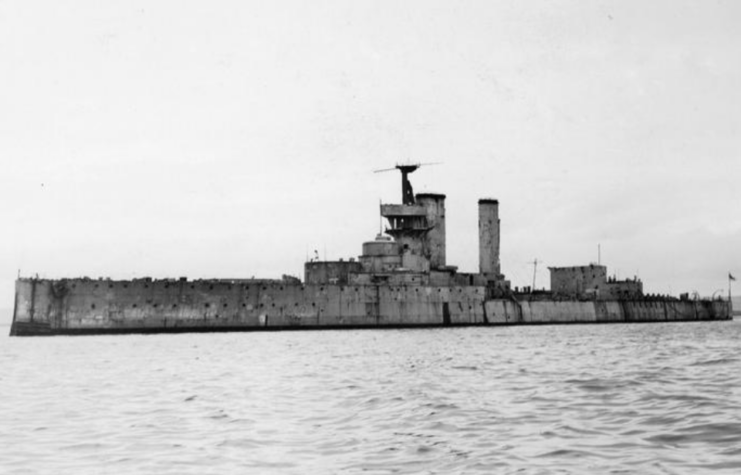
Following the conclusion of the First World War, the HMS Centurion was transferred to the Mediterranean Fleet’s Fourth Battle Squadron. In March 1920, she was put into reserve, although the dreadnought was recommissioned that August.
During the Allied intervention in the Russian Civil War, Centurion was part of prisoner of war (POW) exchanges. When the HMS Tobago (19818) hit a sea mine near Trebizond on November 12, 1920, the dreadnought towed the destroyer to Malta for repairs. In April 1921, she was, again, put into reserve, only to be recommissioned in August ’22.
Returning to Britain after taking part in the Chanak Crisis, Centurion was made the flagship of the Reserve Fleet at Portsmouth. She was then sent to Chatham Dockyard, where she remained through 1925. The following year, Centurion replaced the HMS Agamemnon (1906) as the fleet’s radio-controlled target ship, but was laid up and decommissioned just a few years later in a cost-saving effort.
She was, again, recommissioned in 1933 and conducted dive bomber drills that September. The aircraft scored 19 hits out of the 48 bombs dropped.
Service during World War II
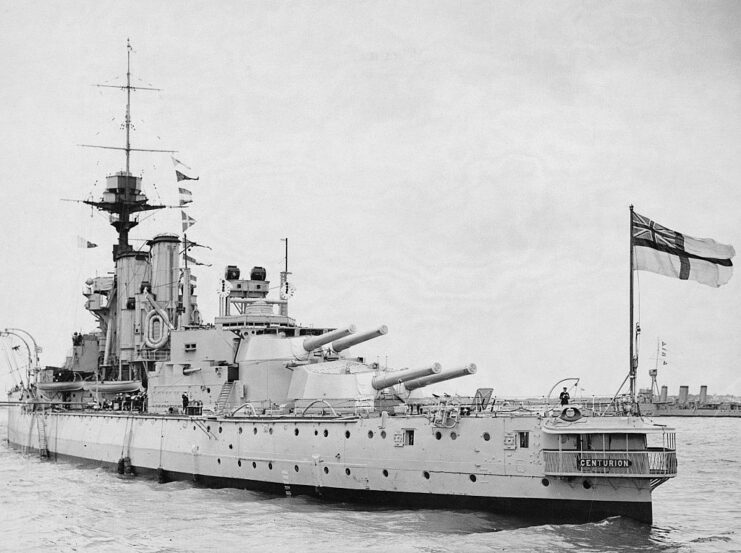
In May 1940, following the outbreak of the Second World War, the HMS Centurion was considered for refitting as an anti-aircraft cruiser for the Norwegian Campaign. Instead, she served as a repair ship, before being converted into a blockship in 1941. She was also considered for use during a naval bombardment of Libya, but this was changed when it was believed success would be slim.
Centurion’s WWII service began out of Gibraltar. Between May and June 1942, she escorted Convoy MW 11 from Alexandria to Malta as part of Operation Vigorous. The hope was the dreadnought being part of the convoy would deceive the Axis powers into believing an operational battleship was present. The Italians didn’t take the bait, although the Germans appeared to be deceived.
Two days after acting as an escort, Centurion was attacked by nine dive bombers, which caused damage due to near misses. She fought back and successfully downed one of the enemy aircraft.
HMS Centurion (1911) during the allied invasion of Normandy
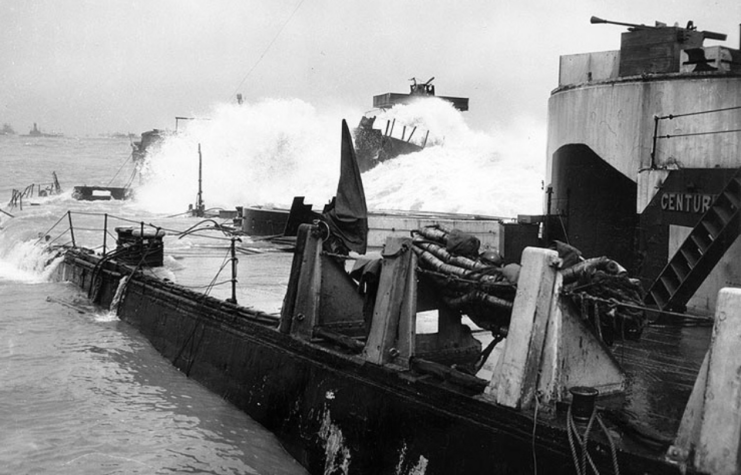
The HMS Centurion’s service ended on June 9, 1944, as part of the Allied invasion of Normandy. She was scuttled to serve as a breakwater as part of Mulberry A, creating sheltered water near Omaha Beach.
Are you a fan of all things ships and submarines? If so, subscribe to our Daily Warships newsletter!
Mulberry Harbors were essential for the Allied invasion, prior to troops gaining access to French ports. Some historians claim the resources used to create them were wasted, particularly the sinking of old ships. That being said, these makeshift harbors brought vital supplies, equipment and soldiers ashore, aiding in the overall success of Operation Overlord.
